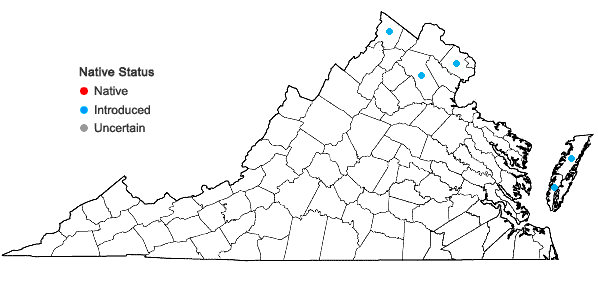Tripidium ravennae (L.) Scholz

Detail
- Family
- Poaceae
- Botanical Name
- Tripidium ravennae (L.) Scholz
- Common Name
- Ravenna-grass
- Synonym(s)
- Saccharum ravennae (L.) L.; Erianthus ravennae (L.) P. Beauv.
- Flora of Virginia Name/Status
- Tripidium ravennae (L.) Scholz
- Comments
- Hodkinson et al. (J. Pl. Res. 115, 2002) developed molecular evidence that the European grass traditionally treated as Erianthus ravennae (L.) P. Beauv. or Saccharum ravennae (L.) L. falls outside the Saccharum clade and belongs in the genus Ripidium. However, Ripidium Trin. 1820 is an illegitimate name, having been earlier applied by Bernhardi (1801) to a fern genus in the Schizaeaceae. The name Tripidium was proposed by Holz (Willdenowia 36, 2006) to replace it.
Introduced from southern Europe and western Asia, this species is only occasionally cultivated, but is showing signs of becoming a frequent escape or adventive, increasingly appearing in places well away from plantings. The current map does not represent the full extent of scattered, escaped populations in the state. Unvouchered populations on highway embankments or median strips have been seen in several counties. In California and other parts of the western U.S., it is considered an invasive weed. It is one of our tallest herbaceous species, frequently 3 meters or more in height. - Habitat
- Old fields, roadsides, and along railroads; usually in moist to damp soils. Infrequent throughout, but apparently spreading rapidly.
- Native Status
- Introduced
To save this map, right-click (control-click for Mac users) on the map and choose "Save Image As...".


